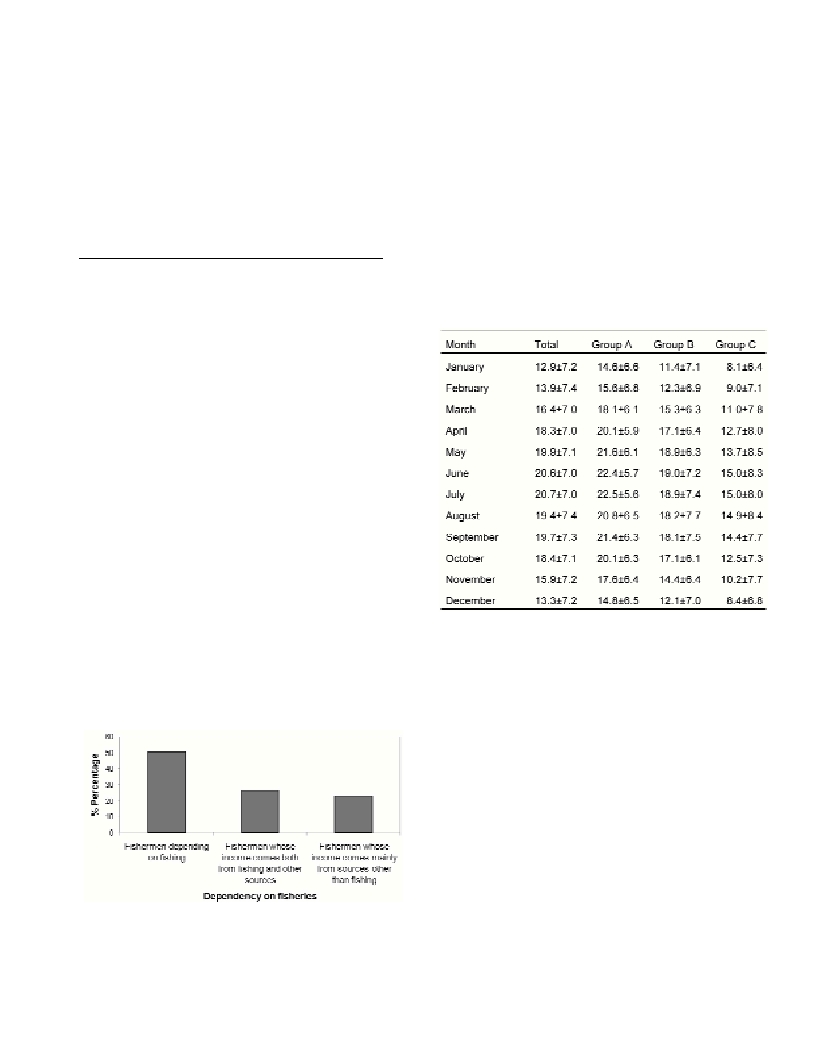TYPOLOGY OF GREEK SMALL-SCALE FISHERIES BASED ON SOCIAL,
ECONOMICAL AND BIOLOGICAL ELEMENTS
E. Tzanatos
1*
, Y. Vlatsiotis
1
, L. Papaharisis
2
, G. Katselis
3
, E. Dimitriou
4
, C. Koutsikopoulos
1
1
Department of Biology, University of Patras, Patra, Greece - * marlab@upatras.gr
2
NIREUS S.A., Athens, Greece
3
Technological Educational Institution of Messolonghi, Messolonghi, Greece
4
Aquaculture Centre of Acheloos, Neohori, Greece
Abstract
A survey for the identification of the characteristics of Greek small-scale fisheries was conducted in 121 ports of 18 prefectures of Greece.
The results showed the traditional, family-dependent and locally varying character of small-scale fisheries. Three groups of fishermen
according to their dependence on fisheries were identified. Fishing activity exhibited a seasonal pattern. The identified complexity of small-
scale fisheries should be taken into account for management implementation.
Keywords: small-scale fisheries, fishermen, typology, Greece
Rapp. Comm. int. Mer Médit., 37,2004
452
Introduction
Small-scale coastal fisheries comprise an important part of Greek
fisheries in terms of landings, vessels and manpower [1, 2].
Overfishing problems have forced the European Union to reduce
fishing effort through reduction in the number of fishermen and
vessels [3]. The biological, economical and social characteristics of
the system “small-scale fisheries” should be examined in order to
optimize the management strategy and facilitate measure
implementation.
Methodology
A total of 549 interviews of small-scale fishermen were conducted
in 121 ports from 18 out of the 40 coastal prefectures of Greece. In
order to obtain a representative sample of the Greek fishermen
population, Greek prefectures were stratified according to the number
of fishermen and the dependence on fisheries, the latter indicated by
the total number of fishermen per population.
Results and discussion
Most Greek small-scale fishermen (64.6%) follow the family
profession. The internal migration is low (85.7% and 68.8% live in the
prefecture and in the place of their birth, respectively), while 65.5%
are either illiterate or have attended preliminary school. The 61.3%
working with other people on-board, work with members of their
family. All these characteristics imply a closed, traditional system
where measure implementation could be difficult.
Small-scale fishermen were categorised in 3 groups, according to
their dependence on fisheries (Fig. 1). Group A: Dependence mainly
on fishing, Group B: Dependence both on fishing and other sources
and Group C: Dependence on other sources of income. These groups
exhibited differences with respect to the total days of activity, income,
vessel technical characteristics and level and means of information.
Bearing in mind that current management policies aim towards
reducing the number of fishermen, these groups should be treated
differently in the licensing procedure in order to control fishing effort
while at the same time minimizing social injustice.
The fishing activity exhibited a seasonal pattern with a peak in
summer months (Table 1). Analysis of variance of monthly activity
showed a significant difference between the 3 fishermen groups
formerly identified (all P-values<0.01). Even though fishing pressure
from small-scale fisheries is difficult to be monitored, it is bound to
follow this seasonal pattern. This pattern varies among different areas
of Greece.
A total of 18 different fishing gears (e.g. nets, longlines, beach
seines, trolling lines) and 62 target species (e.g. Mullus surmuletus,
Pagellus erythrinus, Diplodus vulgaris, Boops boops) were recorded
during the survey, exhibiting intense seasonal and local variability.
The latter is related to the type of the ecosystem (e.g. presence of
lagoons, open sea), the biology of the target species and the existing
legal prohibitions for gear use. The large number and combinations of
gear and target species demonstrate the multispecies-multigear
character of the Greek small-scale fisheries. The combination of these
data along with activity records will result to the identification of the
most important métiers [4, 5], the latter being a useful tool for
fisheries management.
References
1-Stergiou K. I., Christou E. D., Georgopoulos D., Zenetos A., and
Souvermezoglou C., 1990. The Hellenic Seas: Physics, chemistry, biology
and fisheries, Oceanogr. Mar. Biol. An. Rev., 35: 415-538.
2-Anonymous, 2003. Common Fisheries Register, Ministry of
Agriculture, Athens, Greece.
3-Anonymous, 2001. Green Paper on the future of the Common Fisheries
Policy, 40p., Brussels.
4-Mesnil B., and Shepherd J. G. 1990. A hybrid age- and length-
structured model for assessing regulatory measures in multiple-species,
multiple-?eet fisheries, J. Cons. Int. Explor. Mer, 47: 115-132.
5-Ulrich C., Gascuel D., Dunn M. R., Le Gallic B., and Dintheer C.,
2001. Estimation of technical interactions due to the competition for
resource in a mixed-species fishery, and the typology of ?eets and metiers
in the English Channel, Aquat. Livin. Resour., 14: 267-281.
Fig. 1. Groups of fishermen according to their dependency on fisheries
and estimated percentages for Greece.
Table 1. Mean and standard deviation of monthly days of activity of fish-
ermen engaged in the Greek small-scale fisheries and of the three groups
of fishermen identified according to their dependence on fisheries.

